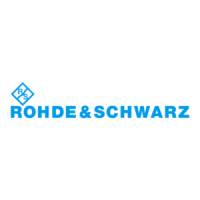Concepts and features
R&S
®
ZNA
162User Manual 1178.6462.02 ─ 20
Calibration Type Standards Parameters Error Terms General Accuracy Application
TRL
(n-port)
Reflect (at both
ports),
Through, Line1,
other Lines
(optional), combina-
tion with TRM
(optional)
All Reflection tracking,
Source match,
Directivity,
Load match,
Transmission track-
ing
High, high directiv-
ity
Reflection and
transmission mea-
surements, espe-
cially for planar cir-
cuits. Limited band-
width.
TNA
(n-port)
Through, Attenua-
tion, Symmetric
network
All Reflection tracking,
Source match,
Directivity,
Load match,
Transmission track-
ing
High, lowest
requirements on
standards
Reflection and
transmission mea-
surements, espe-
cially for planar cir-
cuits.
OSM Scalar Mixer Open, Short,
Match
1)
(at each
port)
All except transmis-
sion phases
Reflection tracking,
source match,
directivity
Low, improves with
complementary ref-
erence receiver cal-
ibration
Scalar mixer mea-
surements, if no
through is available
UOSM Scalar Mixer Open, Short,
Match
1)
(at each
port), Through
All except transmis-
sion phases/delays
Reflection tracking,
source match,
directivity, load
match, transmis-
sion tracking
Medium, high with
complementary ref-
erence receiver cal-
ibration
Scalar mixer mea-
surements, if no
phases/delays are
required
OSM Vector Mixer Open, Short,
Match
1)
(at each
port), Calibration
Mixer
All except feed-
throughs
Reflection tracking,
source match,
directivity
Medium, high for
transmission pha-
ses/delays
Vector mixer mea-
surements, if no
through is available
or only transmission
phases/delays are
measured
UOSM Scalar Vec-
tor Mixer
Open, Short,
Match
1)
(at each
port), Through, Cal-
ibration Mixer
All Reflection tracking,
source match,
directivity, load
match, transmis-
sion tracking
High Scalar and vector
mixer measure-
ments
1)
Or any other 3 known one-port standards. To be used in a guided calibration, the known standards must be declared to be Open,
Short, and Match irrespective of their properties.
2)
Or any other known two-port standard. To be used in a guided calibration, the known standard must be declared to be Through,
irrespective of its properties.
The calibration type must be selected in accordance with the test setup. Select the cali-
bration type for which you can obtain or design the most accurate standards and for
which you can measure the required parameters with best accuracy.
● Normalization (reflection, transmission)................................................................163
● Reflection OSM calibration....................................................................................163
● One Path Two Ports Calibration............................................................................164
● TOSM and UOSM calibration................................................................................164
● Adapter removal....................................................................................................165
● TOM calibration.....................................................................................................167
● TSM calibration..................................................................................................... 167
Calibration

